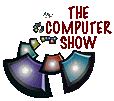HOME
By Al Giovetti
Price:$50
Genre:graphic animated adventure
Release:
Developer: Westwood Studios, www.westwood.com
Lead Artist:
Programmer:
Producer:
Publisher: Virgin Interactive Entertainment
Phone: 800-874-4607
Website:
Requirements:

Support The Computer Show and get paid to surf the web. Click on this Big Bang ad!

Blade Runner
History
The novel, Do Androids Dream of Electric Sleep?, was written by Philip Kindred Dick. The 1982 movie Blade Ruunner, directed by Ridley Scott, was based upon Philip K. Dick's book.
Westwood has produced three cartoon like graphic adventure games based in the fictional world of Kyrandia. The beautiful and detailed art of these games has been perhaps eclipsed by the intricate and daring plot lines loaded with puzzles and twists but typically linear with multiple branch points. Blade Runner tends to be shorter than these earlier efforts and the art is much more complex.
Company Line
Game Play
There are five acts and seven potential endings. The endings differ depending upon whether you want to retire the replicants or whether you want to join them. The game play is not truely open but is linear with branching plot lines to the seven endings. A truely open non-linear world would have been preferred.
Brilliantly executed, and wonderfully faithful to the 1982 Ridley Scot film like cut scenes are found all throughout the game. Travel from one location to another in the aircar is through cut scene animation of the car or of the pilot, Ray McCoy. Unfortunately, you cannot pilot the high tech spinner car, but simply watch as a cut scene takes you from one location to another via the vehicle.
A small Knowledge Information Agent (KIA) or PDA (Personal Data Assistant) stores all the case information and through an interface with the main frame computer allows you to download information collected by others on the case as well as upload your findings.
Movement is remeniscent of 7th Guest rather than Tomb Raider, with you moving along tracks from one perspective position to another by clicking on red arrows that appear in the previous graphic scene. Once at the position you can click on hot spots in the graphics which will lead to your picking up or manipulating items or initiating conversation.
The game tends to be unusually lethal with dead ends. At one point about halfway through compact disk two of four, McCoy kept getting shot at and killed when entering certain areas in the map. Eventually, I was forced to restart the game and try a different path, even though I was unaware of many choices in where to go in the linear plot.
Your choices are limited to whether to shoot people or androids. And the seven endings include killing all the androids, going off at the end with the 14 year old female android, the leader of the renegade andriods, dying, killing your police supervisor. These plot twists hinge around the Voight-Kampff machine for testing replicants which can give different results each time you play the game.
Plot
The plot follows the original movie with a few added parts and sub plots most faithfully. There are even overlays of the original 1982 Blade Runner movie sets and recreations of the original sets used in the game.
Graphics
Dynamic light sourcing adds to the dark and eerie surroundings faithful to the 1982 Ridley Scott film. There are shadows, winking and rotating lights, reflections off the wet pavement, steam and fog, and other very interesting and mood enhancing effects. The lighting includes "volumetric lighting" effects which are most remarkable.
The documentation claims that some of the original sets were used for background, and fans of the film will recognize these locations, such as the Tyrell corporation building and billboards with distintly oriental advertisments.
Animation
Actors motions were captured and their faces intricately replicated in three dimensions on the skeletal framework of a human body using 32,000 polygons and thousands of textures. Extra care was given to the face and hands which seem very lifelike. The movement is lifelike, even though the expressions seem more wooden on the characters than in real life. The animation and sets are clearly three dimensional but your movement through them is less than free, it appears to be on tracks, except in some locations where the movement is somewhat less restricted.
Polygons were converted to voxels to improve fluid motion, but many of the larger voxels used are blocky, suspending disbelief. The animation is amazingly fluid with a variable frame rate which goes no lower than 15 frames per second
Voice Actors
Unfortunately, Harrison Ford and Rutger Howard decided not to return for the film, but most of the other actors are here.
Music Score
Sound Effects
Utilities
The game comes on four CDs.
Multi-player Features
Cheats, Hints, Walkthrough
Journalists
I have always been a fan of Peter Olafson, even though he is a bit austere in one on one discussions, his writing is clear and insightful. Though like most of the games he reviews, his reviews are all to brief. I am always left wanting a little more.
Paula gives us "the real McCoy" review, and shows us that true reviewers cannot resist lame puns. Paula makes the statement that Blade, the game, did not keep up with the increase in technology, but gives us no evidence of this, save to make a vague reference to "texture-mapping and polygon-rendered characters."
Put your review right here by emailing us the text.
References
- Unparalleled Blade Runner Game and Movie FAQs
- Peter Olafson, Review, PC Games, volume 5, number 2, February, 1998, page 81, B (80%).
- Paula Reaume, Boot, volume 3, issue 2, February, 1998, page 74, 8/10 (80%).
